What's going on in goldsmithing Poland ?
The STFZ Informative Bulletin
№ 6 (8) November - December 2005
polish version >>>>
|
The STFZ web site www.stfz.art.pl has been created and exists as result of free volunteer activity of our members. That is why we are sorry for not being able to translate to English all texts in links enclosed, publishing in English just brief information on each of described topic. But please, take a look at the pictures, we believe that with the English texts published they make sensible message on what we do in here. Let us repeat, that we look forward to hear from you on your activities, in order to publish them in our bulletin. Please, forward information on our newsletter to everybody interested in your neighborhood.
|

■ End of the year - as usual - makes our jewellery artists very busy. Galleries will present new propositions to customers, jewellery artists work hard in order to create new pieces for Christmas and New Year selling season. But we always have time to talk, especially on plans for the future. And we've got a lot of 'deals cookin'!
|
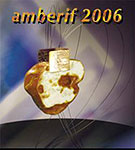
■ Regulation of present edition of the 10th International Competition for the Jewellery with Amber Design - AMBERIF DESIGN AWARD ELEKTRONOS 2006 by occasion of the 13th International fairs of Amber, Jewellery and Gemstones AMBERIF 2006 in Gdansk has been published at www.amberif.pl and www.stfz.art.pl in November 2005. Against our expectation there are no changes in the regulation, jury will be working as in former editions of this competition, evaluating not ready pieces but their pictures or designs submitted for presentation on two dimensional plates.
|
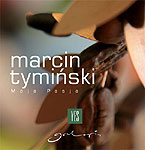
■ The YES Gallery of Poznan has been presenting exhibition titled "MOJA PASJA" - MY PASSION" by Marcin Tyminski, one of most active Polish jewellery designers of last years. His pieces are prompting audience to deeper reflection. The exhibition has opened on November 17th and closed on December 17th 2005. The catalogue is published here: www.stfz.art.pl/galeria/katalog-tyminski.html
|
|
■ The round, tenth edition of the exhibition traditionally organized at the Warsaw' MILANO gallery has opened on December 2nd 2005. This year the title - subject was "Kreatywnego działania wynik" translated by organizers as "Creative action result". 54 authors have submitted their pieces, and four more were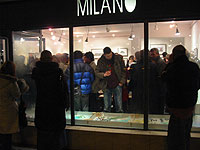 exhibiting ex competition. As usual beside established artists, permanently contributing to the MILANO gallery, there were participating students and graduates of art schools plus persons cooperating with fashion designers. The part of the MILANO exhibitions tradition is the jury recruiting from the owners' family and "friends and relations of rabbit" circle. Thus pieces were judged by Elzbieta Kochanek- van Dijk, Maryla Weiss, Agnieszka Medrzecka, Marta Kochanek-Zbroja, Martin van Dijk, Wiktor Zbroja and Kuba Kochanek. Pieces submitted were awarded by three awards and four distinctions, but the final evaluation was rather difficult, because more pieces deserve to be distinguished. Here we have photos of presented jewellery: http://www.stfz.art.pl/2005/milano2-a.html exhibiting ex competition. As usual beside established artists, permanently contributing to the MILANO gallery, there were participating students and graduates of art schools plus persons cooperating with fashion designers. The part of the MILANO exhibitions tradition is the jury recruiting from the owners' family and "friends and relations of rabbit" circle. Thus pieces were judged by Elzbieta Kochanek- van Dijk, Maryla Weiss, Agnieszka Medrzecka, Marta Kochanek-Zbroja, Martin van Dijk, Wiktor Zbroja and Kuba Kochanek. Pieces submitted were awarded by three awards and four distinctions, but the final evaluation was rather difficult, because more pieces deserve to be distinguished. Here we have photos of presented jewellery: http://www.stfz.art.pl/2005/milano2-a.html
|
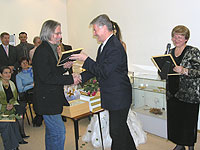
■ The first edition of an International Competition for Artistic Works in Amber ALATYR 2005 closed on December 2005 in Kaliningrad, Russia. More then fifty artists coming from: Russia, Lithuania, Germany, Holland, Japan and other countries have submitted their pieces for the competition. Between these artists we find names of Beate Klockman, Judy McCaig, Katja Prins, Silvia Walz, Wilhelm Tasso Mattar, Philip Sajet, Theo Smeets, Manuel Vilhena, Michael Zobel. We note significant presence of Polish artists: Giedymin Jablonski, Mariusz Gliwinski, Jan Materek, Marek Nowaczyk, Andrzej Pacak, Mariusz Pajaczkowski and others. Professor Andrzej Szadkowski of Academy of Fine Arts by the name of Wladyslaw Strzeminski of Lodz has been invited to jury. more >>>>
|
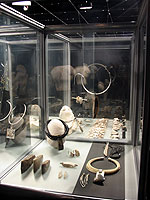
■ At the Critic Gallery POKAZ translating as SHOW or PRESENTATION in Warsaw, Cezary Lutowicz has opened his exhibition named "STRUKTURY FAKTURY FORMY" - "STRUCTURES, TEXTURES, FORMS" (http://www.stfz.art.pl/2005/pokaz12a.html) on December 7th 2005. There is also the modest catalogue edited for this exhibition. For more then thirty years Cezary Lutowicz creates unique jewellery with stripped flintstone as dominating element. We may risk saying that it is our author who has introduced this so decorative gem into jewellery world. This stripped flintstone is to be found in Poland only. Due to tireless, thirty years long efforts the stripped flintstone is today known in the world. Cezary Lutowicz tells on his beloved stripped flintstone at his Internet site www.krzemien-sandomierz.pl.
|
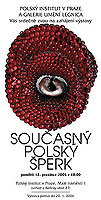
■ The second edition of exhibition "Wspolczesna polska sztuka zlotnicza" - "Contemporary Polish goldsmithing art" has opened on December 12th 2005 at the Polish Institute in Prague, the Czech Republic. This exhibition organized by the Art Gallery of Legnica, has been already presented in Wuppertal, and will be shown in the future in Denmark, Hungary, France, Russia, Austria, Slovakia, Germany, Italy, and it's native Poland. Please, feel invited to see pictures of works published in the catalogue.
fotorelacja >>>>
katalog >>>>
|
|
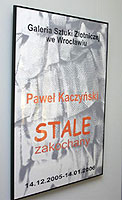 ■ "STALE zakochany" translating as "permanently in love" is the title of exhibition of Pawel Kaczynski that opened in at the STANKO GALLERY in Wroclaw on December 14th 2005. The title is based on play of words: STALE means permanently, but STAL means steel, what is a reference to material used by an artist. Perhaps better translation would be: "In love with steel".
■ "STALE zakochany" translating as "permanently in love" is the title of exhibition of Pawel Kaczynski that opened in at the STANKO GALLERY in Wroclaw on December 14th 2005. The title is based on play of words: STALE means permanently, but STAL means steel, what is a reference to material used by an artist. Perhaps better translation would be: "In love with steel".
This exhibition is the fourth individual exhibition of Pawel Kaczynski in the year 2005. So intensive activity caused the Wroclaw show to open on the end of the 2005 year. Before the event at the STANKO GALLERY Kaczynski has been presenting his pieces in May 2005 during the Legnica Festival of Silver in cycle "Silhouettes of creators". This exhibition was accompanied by catalogue, edited by the Legnica Art Gallery and the artist. Collection shown in Legnica with addition of new pieces was presented in the BWA - Office for Art Exhibition gallery in Bielsko, and later - also with some new creations - at the SKARBIEC gallery in Krakow. The Wroclaw edition closes this cycle of presentations.
more >>>>
|
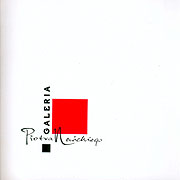
■ After almost thirty years of it's existence the Warsaw's PN Gallery of Piotr Nowicki, has closed on the very end of December 2005. This gallery was situated at the backyard of the Nowy Swiat and Smolna Street, the adress was: Nowy Swiat Str. 26, pavillon nr. 5, 00 373 Warsaw, PL.
The PN gallery has been the very first private art gallery in post war Poland, and has played most significant role in process of development and promotion of contemporary Polish art.
The PN gallery has opened on February 14th, 1997 year. From the beginning leading Polish goldsmiths artists of that time have been cooperating with this gallery. One man exhibitions of: Joachim Sokolski, Jacek Byczewski, Tadeusz Klimczak and works by Jacek M. Hohensee including his objects and stone jewellery plus graphics were presented at the PN gallery.
 Piotr Nowicki has been sending Christmas, New Year and Easters season greetings on cards illustrated by renowned Polish cartoonist, Edward Lutczyn. These drawings were always making satiric comment on present situation at home. Here let me extend our sincere thanks to Edward Lutczyn for his kind permission to publish in this bulletin some of his PN gallery cards. Let them serve as special commemoration of the pioneering for our condition the PN gallery. Piotr Nowicki has been sending Christmas, New Year and Easters season greetings on cards illustrated by renowned Polish cartoonist, Edward Lutczyn. These drawings were always making satiric comment on present situation at home. Here let me extend our sincere thanks to Edward Lutczyn for his kind permission to publish in this bulletin some of his PN gallery cards. Let them serve as special commemoration of the pioneering for our condition the PN gallery.
|
|
■ The opportunity of permanent presentation of our goldsmithing art in Warsaw appeared somehow in December 2005. For many years the STFZ has been working hard, trying to find proper place in the capital to present exhibitions and results of competitions organized by the Legnica Art Gallery and our association. More detailed information will be published in next issue of our bulletin.
|
|
From the past
■ The exhibition of artistic jewellery by the OW ZPAP - Warsaw branch of Association of Polish Artists in 1971
After the end of Second World War until introduction of Martial law in 1981 many Polish artists working in silver have been creating designs on request of the Biuro Nadzoru Estetyki Produkcji - BNEP, translating as Office for supervision of esthetic of manufacturing, organized an runned by prof. Wanda Telakowska (1905-1985), 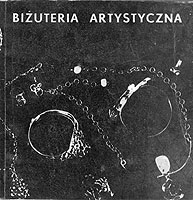 later transformed to Instytut Wzornictwa Przemyslowego - Institute of Industrial Design. Results of this cooperation were presented at exhibition opened on July 4th 1999 in the Museum in Kazimierz accompanied by catalogue, presenting artists of early post war time. We have been already writing on this subject in bulletin 2(4) later transformed to Instytut Wzornictwa Przemyslowego - Institute of Industrial Design. Results of this cooperation were presented at exhibition opened on July 4th 1999 in the Museum in Kazimierz accompanied by catalogue, presenting artists of early post war time. We have been already writing on this subject in bulletin 2(4)
Discipline of artistic goldsmithing has been organizationally represented by ZPAP - Polish Artists Association until introduction of Martial Law in 1981 year. Many artists of elder generation, who, after the war were cooperating with mentioned BNEP, have been active on forum of the ZPAP, being members of this association.
Within organizational frames of ZPAP our discipline was at first represented at Podsekcja do Spraw Zlotnictwa Artystycznego przy Sekcji Architektury Wnętrz i Sztuki Dekoracyjnej Okręgu Warszawskiego ZPAP ( AW i SD OW ZPAP) - Subsection of Artistic Goldsmithing by Section of Interior Design and Applied Arts of ZPAP Warsaw Branch, which later transformed into Subsection for Artistic Goldsmithing by ZPAP Warsaw Branch, and later into Interdisciplinary Commission for Artistic Goldsmithing, covering all Poland. Warsaw was leading center, so most organizational works were performed by artists - ZPAP members from Warsaw. This way more significant exhibitions of artistic jewellery of sixties and seventies were organized by Warsaw circle. Examples of such exhibitions are:
- two individual exhibitions of family team of Jadwiga and Jerzy Zaremski, presented at the Zacheta gallery in Warsaw in 1962 and 1970. These exhibitions have enforced the position of our artistic silver between other disciplines of applied art. One of journalists has developed the term "Democratic jewellery" as jewellery easily accessible to average customer due to cheap materials used by artists.
- group exhibitions of Warsaw Branch of Association of Polish Artists - ZPAP organized in 1962 and 1968 and presented at Dom Artysty Plastyka - House of an Artist building in Warsaw by Mazowiecka street nr. 11a.
Exhibitions indicated above did not, unfortunately, play more significant role informing abroad on our artistic goldsmithing. Spectacular success of our leading artists - Jadwiga and Jerzy Zaremski first of all - in Pforzheim, Stuttgart, Arezzo, or Jablonec in former Czechoslovakia did not promote our artistic jewellery as fierld of creativity developing in Poland. This has prompted us to publish below the note on exhibition opened in summer 1971 at Dom Artysty Plastyka - House of an Artist building in Warsaw by Mazowiecka street nr. 11a, because this exhibition was presented later abroad in Singapore and Djakarta, and positive reception of works presented has influenced and accelerated organization of exhibition of Polish artistic jewellery in Centers of Polish Culture in Berlin, Stockholm and Bratislava (Pressburg).
Exhibition titled by simple name Bizuteria Artystyczna - Artistic Jewellery, organized by Warsaw Branch of Association of Polish Artists opened on July 8th 1971 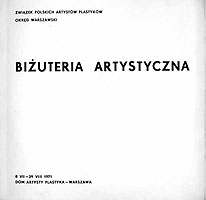 in exhibition rooms of Dom Artysty Plastyka - House of an Artist building in Warsaw by Mazowiecka street nr. 11a and has been open until July 29th 1971. The jury members were: Konstanty Danko, Roman Falencik, Irena Huml, Adam Jabłonski, Miroslawa Miller, Jerzy Sendlak, Stanislaw Sikora, Eugeniusz Szparkowski, Konstanty Tiunin and Olgierd Vetesco. Let us remind, that prof. Irena Huml is prominent historian of art specializing in contemporary Polish artistic jewellery, an artist Adam Jablonski has been for years the artistic director of the ORNO cooperative in Warsaw and is an author of considerable number of rector's and dean's chains and other insignia created by the ORNO team for domestic schools of academic level. One of Jablonski's most prominent realisations is large gate to the Cathedral Church at Warsaw Old Town, repoused in copper by the ORNO team. Artists: Miroslawa Miller, Olgierd Vetesco, Jerzy Sendlak belong to most prominent representatives of Polish School of Silver style. An artist Konstanty Tiunin has been working in mosaic technique, artist Kaja Szymanska is known in Poland as forerunner, precursor of technique of veawing using thin wires of silver - technique that the world knew from achievements and book by an American artist - prof. Arline Fish. in exhibition rooms of Dom Artysty Plastyka - House of an Artist building in Warsaw by Mazowiecka street nr. 11a and has been open until July 29th 1971. The jury members were: Konstanty Danko, Roman Falencik, Irena Huml, Adam Jabłonski, Miroslawa Miller, Jerzy Sendlak, Stanislaw Sikora, Eugeniusz Szparkowski, Konstanty Tiunin and Olgierd Vetesco. Let us remind, that prof. Irena Huml is prominent historian of art specializing in contemporary Polish artistic jewellery, an artist Adam Jablonski has been for years the artistic director of the ORNO cooperative in Warsaw and is an author of considerable number of rector's and dean's chains and other insignia created by the ORNO team for domestic schools of academic level. One of Jablonski's most prominent realisations is large gate to the Cathedral Church at Warsaw Old Town, repoused in copper by the ORNO team. Artists: Miroslawa Miller, Olgierd Vetesco, Jerzy Sendlak belong to most prominent representatives of Polish School of Silver style. An artist Konstanty Tiunin has been working in mosaic technique, artist Kaja Szymanska is known in Poland as forerunner, precursor of technique of veawing using thin wires of silver - technique that the world knew from achievements and book by an American artist - prof. Arline Fish.
The exhibition has been presenting pieces by 29 artists or family teams - like the team of Jadwiga and Jerzy Zaremski. The catalogue accompanying the exhibition begins with foreword by prof. Irena Huml. Then came list of jury members and of participants. Each participant is represented by photo of his or her piece and list of works exhibited. Despite very low quality of photos it is possible to get an impression on estetic of Polish artistic silver jewellery of these days.
|
■ Chatelaine
Things connected with simple and banal sounding objects like ordinary keys have participated in history of culture in different ways. Some of these aspects are social role and their importance of persons in charge of keys - holding keys, thus responsible for keeping order at home or at  real estate. Other aspects are different objects used for keeping the set of keys together. These mentioned first are, for instance titles of chatelaine, steward or key holder, and we do not have to remind Polish readers on characters from our literature and art - like the tangible character of Gerwazy the Key Holder from our XIXth century national epos Pan Tadeusz by Adam Mickiewicz. The English speaking readerland is, perhaps, familiar with magazine Chatelaine and web site http://www.chatelaine.com/, addressed to contemporary chatelaines - ladies of the house. real estate. Other aspects are different objects used for keeping the set of keys together. These mentioned first are, for instance titles of chatelaine, steward or key holder, and we do not have to remind Polish readers on characters from our literature and art - like the tangible character of Gerwazy the Key Holder from our XIXth century national epos Pan Tadeusz by Adam Mickiewicz. The English speaking readerland is, perhaps, familiar with magazine Chatelaine and web site http://www.chatelaine.com/, addressed to contemporary chatelaines - ladies of the house.
There were and still there are different ways of keeping keys. I see recently keys kept on neck lashes, sometime with embroided inscriptions and with proper snap hook keeping keys. I remember truck drivers, workers and foremen keeping keys at the trousers belt loop fixed by special snap hooks. Similarly I noticed the use of sailor's shackle as specific key ring also serving as key holder.
In old days there was a special object, often manufactured by goldsmiths from silver. The name of it was chatelaine. It had a form of complex, decorative hanger with special hook to fix it 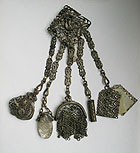 secure at the belt. It has been used for keeping by hand small objects for householding, so on short chains there were fixed hooks for hanging/fixing keys, small scissors, thimble, different containers. Another form of chatelaine was single metal container, adorned with repousse ornament, serving as a box to keep all necessary tools, objects or other utensilias inside. secure at the belt. It has been used for keeping by hand small objects for householding, so on short chains there were fixed hooks for hanging/fixing keys, small scissors, thimble, different containers. Another form of chatelaine was single metal container, adorned with repousse ornament, serving as a box to keep all necessary tools, objects or other utensilias inside.
Such chatelaines exist from XVIIth century up to XIXth century. Therefore we are happy to inform that in one of Polish XXth century magazines, namely in magazine "Złotnik i Zegarmistrz" - Goldsmith-Watchmaker, nr. 2 from February 18th 1937 there is an advertisement of I. M. Alland and Sons Company situated in Warsaw, Kacza street nr 17. Between other products there is indicated also szatlenki, what is definitely Polish form of the word chatelaine. More in column Lemel published in 2002 in magazine Polski Jubiler - Polish Jeweller.
Nice example of chatelaine is exposed at the National Museum in Warsaw. This text is illustrated by images of two pieces belonging to the private collection in Warsaw.
|
|